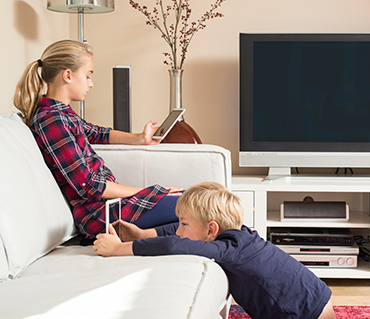New risk from too much screentime
Teens — and everyone else, it seems — spend an unhealthy amount of time sitting, a new survey finds

A national survey shows Americans spend a lot of time sitting in front of screens.
g-stockstudio/iStock/Getty Images Plus
By Mary Bates
You might want to take this news standing up. A national survey finds that Americans of all ages are spending more time sitting. And this has health experts worried.
Sitting too much — especially when watching television, phones or other screens — can be bad for your health, research suggests. It has been linked to diseases such as diabetes and cancer. It also has been tied to an increased risk of mental health issues, such as anxiety and depression.
In a new study, researchers analyzed survey data from more than 50,000 American children, teenagers and adults. The surveys, which went from 2001 through 2016, asked people how much time they spent sitting. The results of those surveys were published April 23 in the Journal of the American Medical Association.
Overall, people reported sitting a lot. For instance, close to two-thirds of children and teens said they sat at least two hours a day watching television or videos. The data also showed that computer use outside of school or work has been increasing across all ages.
For adults and teens, the estimated total time sitting increased by nearly one hour a day between 2007 and 2016. That means teens now sit more than eight hours a day.

Lin Yang is a public-health expert at Alberta Health Services in Calgary, Canada. An author of the new study, she notes that this trend is not unique to the United States. “Studies out of Europe and Australia have also found increases in sitting time,” she says. “This includes sitting for work or school as well as driving rather than walking or riding a bike.”
In recent years, inactivity has emerged as an important risk to overall health. The U.S. Department of Health and Human Services updated its Physical Activity Guidelines for Americans last year. It now highlights new research about the dangers of excessive sitting. “This new version recommends Americans not only move more, but also sit less,” Yang says.
Erin O’Loughlin is an exercise psychologist at Concordia University in Montreal, Canada. There are many reasons children and teens have been sitting more, she notes. These include less outdoor play, more screen time and schools that have been reducing opportunities for exercise during the school day.
O’Loughlin studies how active video games — sometimes called “exergames” — can help kids move more. “Sports are great. But you don’t have to play sports if that’s not your thing,” she says. To up your active time and sit less, she recommends finding what works for you. “If you like screen time, try to mix it with physical activity,” she says. “You can do this by playing active video games.”
People tend to think they spend less time sitting and more time exercising. The first step to getting healthier is becoming aware of how active — or inactive — you are, says O’Loughlin. Activity trackers can help. Their apps give people the data to track trends. So can thinking about which daily activities get you to move most.
“We all need to move more and sit less,” says Yang. “It’s important to not just switch from sitting to standing but to actually move around.” And spending more time outside helps, she notes. This is good for fitness and for exposure to the sun, an important source of the body’s vitamin D.
If getting more exercise sounds difficult, don’t stress: Take it one step at a time.







